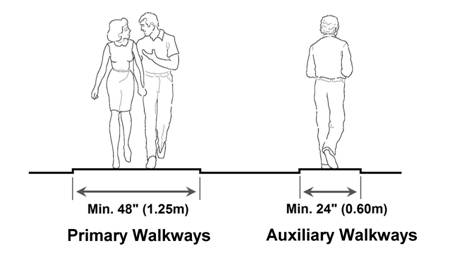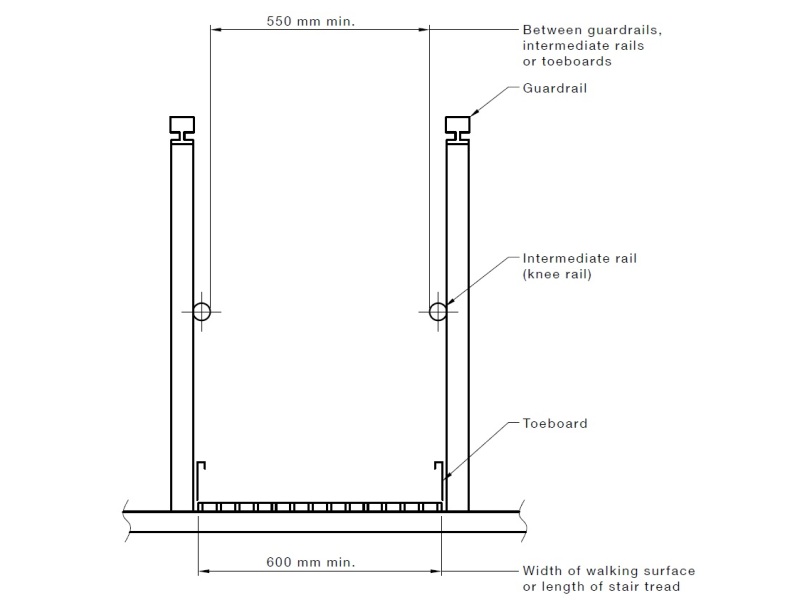Understanding the Minimum Walkway Width Australia: Guidelines and Best Practices

When designing public spaces and pathways in Australia, understanding the minimum walkway width is crucial for ensuring accessibility and safety. This article delves into the guidelines and best practices for walkway dimensions, highlighting their importance for accommodating pedestrian traffic, especially in high-usage areas. With a focus on Australian standards, we will explore factors influencing walkway width, including local regulations, user demographics, and environmental considerations. By adhering to these guidelines, planners and architects can create functional and inclusive spaces that enhance the overall experience for all users, promoting a more walkable and accessible urban environment.
Minimum Walkway Width Regulations in Australia
The minimum walkway width in Australia is essential for ensuring safe and accessible pedestrian movement in various settings, including residential, commercial, and public areas. The regulations dictate that walkways must be wide enough to accommodate the flow of foot traffic while considering the needs of individuals with disabilities. Generally, the minimum recommended width for walkways is around 1.2 meters to allow for the comfortable passage of individuals, including those using mobility aids such as wheelchairs. Compliance with these standards not only enhances safety but also facilitates a more inclusive environment for all users.
Key Legislation Governing Walkway Widths
In Australia, building codes and local council regulations establish the guidelines for minimum walkway widths. The Building Code of Australia (BCA) outlines specific requirements that address the needs of various building types and uses. These regulations ensure that walkways are adequately sized for emergency evacuations and accessibility. Local councils may impose additional standards, emphasizing the importance of assessing site-specific conditions that can affect walkway dimensions.
Importance of Walkway Width for Accessibility
Accessibility is a critical concern in urban planning and design, and the minimum walkway width plays a significant role in achieving this goal. Wider walkways facilitate ease of movement for individuals with disabilities, older adults, and parents with strollers. The presence of features such as curb ramps and tactile ground surface indicators can further enhance accessibility. Adhering to the recommended widths not only meets legislative requirements but also promotes an inclusive environment for all members of the community.
Factors Influencing Walkway Width Requirements
Several factors influence the determination of minimum walkway widths, including foot traffic volume, the surrounding land use, and the intended purpose of the walkway. Urban areas with high pedestrian traffic may require wider walkways to accommodate group movement and reduce the risk of congestion. Additionally, communal spaces, such as parks or shopping districts, might necessitate more extensive pathways to facilitate comfortable circulation for various activities and events.
Walkway Width Variations in Different States
While there are general guidelines for minimum walkway width across Australia, specific requirements can vary by state and territory. Each region may have its own local government regulations that dictate the width of walkways to suit its unique context, such as population density and urban layout. For example, cities with higher pedestrian traffic may set wider minimum widths compared to rural areas, reflecting the differing demands on pedestrian infrastructure.
Best Practices for Designing Walkways
Designing effective walkways involves considering several best practices, including maintaining the minimum width standards and ensuring unobstructed pathways. It is recommended to incorporate visual elements like lighting and signage along walkways to enhance safety. Additionally, using materials that provide good traction in various weather conditions can improve accessibility. Continuous evaluation and updating of walkway standards ensure they meet the evolving needs of the community, promoting safe and welcoming environments for all pedestrians.
| Aspect | Recommended Minimum Width | Location Type |
|---|---|---|
| Residential Areas | 1.2 meters | Family Homes |
| Commercial Zones | 1.5 meters | Shopping Districts |
| Public Parks | 2.0 meters | Parks & Recreational Areas |
| Civic Spaces | 2.5 meters | Public Squares |
| High Traffic Areas | 3.0 meters | Main Thoroughfares |
What is the minimum width of a walkway in factory Australia?

In Australia, the minimum width of a walkway in a factory setting is generally determined by the relevant Australian Standards and often by workplace safety regulations. According to the Australian Standard AS 1657 pertaining to fixed platforms, walkways, stairways, and ladders, the minimum width for walkways should be at least 600 mm to ensure safe passage for personnel, particularly in high-traffic areas.
Factors Influencing Walkway Width
The required width of a walkway can be influenced by several factors related to the working environment and the expected traffic:
- Workplace Activity: The type of work being performed can necessitate wider walkways if equipment or materials are frequently moved.
- Number of Workers: Areas with higher personnel density may require wider walkways to prevent congestion and enhance safety.
- Types of Equipment: If large equipment operates in proximity to walkways, a greater width may be necessary to provide a safe distance.
Importance of Compliance
Ensuring compliance with the minimum width requirements is crucial for several reasons:
- Safety: Adequate walkway space significantly reduces the risk of accidents and improves overall workplace safety.
- Efficient Movement: Sufficient width facilitates easier movement of personnel and materials, leading to improved operational efficiency.
- Legal Obligations: Adhering to the standards helps organizations meet their legal obligations, potentially minimizing liability in case of incidents.
Additional Recommendations
While adhering to the minimum width is essential, several additional recommendations can improve walkway safety:
- Clear Signage: Install signs to indicate pedestrian pathways and restrictions on items that can obstruct walkways.
- Regular Maintenance: Conduct regular inspections and maintenance to ensure walkways remain unobstructed and in good condition.
- Training: Provide training for employees on the importance of keeping walkways clear and safe.
Walkway Design Considerations
Walkway design must take into account several critical aspects to maximize safety and usability:
See also:
- Surface Material: Choose materials that provide good grip and are slip-resistant, especially in areas that may encounter spills.
- Lighting: Ensure that walkways are well-lit to enhance visibility, particularly in low-light conditions or during nighttime operations.
- Accessibility: Design walkways to accommodate individuals with mobility impairments, adhering to relevant accessibility standards.
Evaluating Existing Walkways
If existing walkways do not meet the minimum width, it is essential to evaluate and take corrective actions:
- Assessment: Conduct thorough assessments of current walkway widths and their usage during peak times.
- Modification: Consider widening narrow walkways through reallocation of space or redesigning the area.
- Consultation: Engage with safety officers and workforce representatives to gather input on walkway safety and comfort.
What width should a walkway be?

The recommended width for a walkway can vary depending on its intended use and the number of people expected to use it. Generally, a standard walkway should be at least 3 feet (0.9 meters) wide to accommodate pedestrians comfortably. However, wider walkways are advisable in high traffic areas or where mobility aids such as wheelchairs or strollers are used. Here are some guidelines to consider:
Factors Influencing Walkway Width
The width of a walkway is influenced by several key factors:
- Traffic Volume: The more users expected, the wider the walkway should be to avoid congestion.
- Type of Use: Walkways serving recreational spaces may require more width than those in residential areas.
- Accessibility: Compliance with accessibility standards often necessitates a wider pathway for individuals with disabilities.
Recommended Widths for Different Uses
Different types of walkways have varying width recommendations:
- Residential Walkways: Typically, these should be at least 3 to 4 feet (0.9 to 1.2 meters) wide.
- Commercial Areas: Walkways in shopping centers or urban environments should be a minimum of 5 feet (1.5 meters) wide.
- Parks and Recreation: Multi-use paths can range from 6 to 10 feet (1.8 to 3 meters) to accommodate cyclists and pedestrians.
Building Codes and Regulations
Local building codes may impose specific requirements regarding walkway width:
- Accessibility Laws: Regulations such as the Americans with Disabilities Act (ADA) stipulate minimum walkway widths.
- Safety Compliance: Fire codes may dictate certain widths for emergency access routes.
- Local Ordinances: Some municipalities have regulations detailing appropriate widths for public spaces.
Design Considerations for Walkways
When designing a walkway, several design aspects should be considered:
- Pathway Materials: Certain materials can influence the effective width due to curb and edge treatment.
- Landscaping: Avoiding overgrown vegetation can help maintain a clear walkway.
- Adjustments for Slope: Sloped areas may require additional width for safety and ease of navigation.
Tips for Choosing the Right Width
To ensure a functional and comfortable walkway, consider the following tips:
- Assess Expected Traffic: Analyze foot traffic patterns to determine a suitable width.
- Survey User Needs: Consider the needs of potential users, including wheelchairs and strollers.
- Flexibility in Width: Design for potential future needs by considering wider pathways if your location experiences growth.
What is the minimum width of a walkway as1657?

The minimum width of a walkway according to AS 1657, which pertains to the design, construction, and installation of walkways, stairways, and ladders in industrial structures, is set based on several criteria to ensure safety and accessibility.
Regulatory Guidelines
The AS 1657 standard provides specific regulatory guidelines that must be followed when determining walkway widths. These guidelines are essential for:
- Safety: Ensures that walkways can accommodate foot traffic safely.
- Accessibility: Aims to provide universal accessibility for all users, including those with disabilities.
- Maintenance: Wider walkways facilitate easier maintenance and cleaning procedures.
Minimum Required Width
The minimum required width for walkways specified in AS 1657 is generally 600 mm (millimeters). However, this width can vary based on the following factors:
- Usage: Heavily trafficked areas may require wider walkways.
- Type of facility: Industrial facilities might have different requirements compared to commercial spaces.
- Compliance with local codes: Local building codes might impose stricter requirements.
Factors Influencing Walkway Width
Several factors can influence the overall width required for walkways in compliance with AS 1657:
See also:
- Foot Traffic Volume: High pedestrian traffic may necessitate additional width.
- Equipment and Material Transport: Walkways need to accommodate movement of materials or equipment safely.
- Emergency Access: Sufficient width must allow for emergency evacuation and access for emergency services.
Design Considerations
When designing a walkway according to AS 1657, consider the following design aspects:
- Path Alignment: Straight paths are typically preferred over curved paths for safety purposes.
- Surface Material: The material chosen can affect slip resistance, impacting the effective usability of the walkway.
- Light and Ventilation: Adequate lighting and ventilation enhances usability and safety for pedestrian traffic.
Compliance and Best Practices
Ensuring compliance with AS 1657 involves adopting the following best practices:
- Regular Inspections: Conduct inspections to maintain safety and compliance.
- User Feedback: Collect user feedback to identify any accessibility issues.
- Training for Users: Provide training on the safe usage of walkways, especially in industrial environments.
What is the minimum width of a walkway in a factory?

The minimum width of a walkway in a factory generally depends on safety regulations and the type of work being performed. In the United States, the Occupational Safety and Health Administration (OSHA) sets forth guidelines that state walkways should be at least 36 inches wide. However, some specific applications and local regulations may require wider walkways to accommodate larger equipment or more significant foot traffic.
Here are some essential aspects regarding the minimum width of a walkway in a factory:
Importance of Walkway Width
The width of a walkway is crucial for several reasons:
- Safety: Adequate walkway width reduces the risk of accidents, allowing for safe movement.
- Accessibility: Wider walkways make it easier for people with disabilities or those using mobility aids to navigate.
- Traffic Flow: A properly sized walkway helps manage the flow of foot traffic, minimizing bottlenecks.
Factors Influencing Walkway Width
Several factors can influence the minimum width required for walkways in factories:
- Type of Work: Different tasks may necessitate wider walkways, especially if equipment or materials must be transported.
- Employee Safety: More employees in a confined space may need additional width for safety during emergencies.
- Equipment Size: Larger machinery or vehicles may require broader walkways to navigate effectively.
Compliance with Regulations
Compliance with safety regulations is essential to prevent workplace accidents:
- OSHA Standards: Follow OSHA guidelines for walkway dimensions to ensure a compliant work environment.
- Local Codes: Check local regulations, as they may have specific standards that differ from federal rules.
- Periodic Review: Regularly reviewing walkway dimensions to ensure ongoing compliance is vital for safety.
Creating an Efficient Walkway Design
Designing an efficient walkway involves several considerations:
- Placement: Position walkways in high-traffic areas to optimize movement.
- Materials: Use non-slip materials to enhance safety during various industrial processes.
- Visual Aids: Implement signs and markings to indicate walkways clearly and improve navigation.
Regular Maintenance of Walkways
Maintaining walkways is crucial for safety and efficiency:
- Regular Inspections: Conduct routine checks to identify wear, damage, or obstructions.
- Cleaning: Keep walkways clean and clear to ensure safe passage.
- Repairs: Promptly address any issues such as cracks or protruding debris to prevent accidents.
Questions from Our Readers
What is the minimum walkway width required in Australia?
The minimum walkway width in Australia typically varies based on specific building codes, but it is generally recommended to be at least 1 meter for pedestrian pathways to ensure safe and comfortable passage.
Are there different requirements for commercial versus residential walkways?
Yes, there are often different standards; commercial walkways may require wider dimensions, typically around 1.5 to 2 meters, to accommodate higher foot traffic and comply with accessibility regulations.
What factors influence the walkway width regulations in Australia?
Walkway width regulations can be influenced by factors such as local council regulations, the intended use of the walkway, traffic volume, and accessibility needs for individuals with disabilities.
See also:
Can walkway widths be adjusted based on specific site conditions?
Yes, walkway widths can be adjusted based on specific site conditions; however, any changes must still comply with the relevant building codes and safety standards to ensure usability and safety for all pedestrians.

If you want to read more articles like Understanding the Minimum Walkway Width Australia: Guidelines and Best Practices, we recommend you check out our Landscaping category.
Leave a Reply
Related Articles